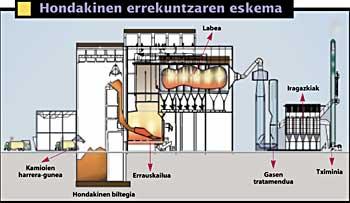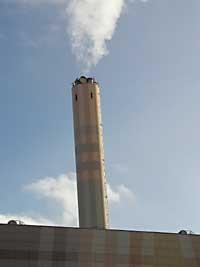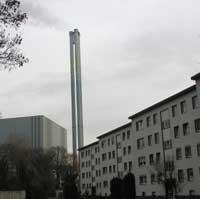Start-up of incinerators
2004/10/01 Kortabarria Olabarria, Beñardo - Elhuyar Zientzia Iturria: Elhuyar aldizkaria
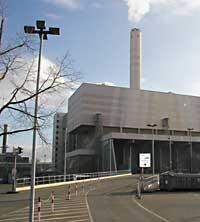
The first garbage incineration facilities appeared in the 1970s. Instead, more than the incinerators were incinerators, since they had nothing to do with the oven. They were limited to the burning of garbage without any treatment on the gases generated and the possible discharges. Nor was it taken into account what was put in the oven. They smoked everything.
The subsequent incinerators advanced a little, since they had treatments for the gases generated in combustion, although they were not very efficient. It lasted until the 1990s.
From there, landfills have been mainly used to solve the problem of waste. However, in recent years, the problem of landfills, increasing space and the generation of polluting gases and leachates, is causing the proliferation of waste incineration plants. However, in many places without local problems, as in Castile, the solution of landfills remains a priority.
XX. The incinerators, created at the end of the 20th century, in addition to improving the treatment of gases, incorporated to their task an added effectiveness: they began to use combustion to generate energy. However, with dioxins and other toxic substances they did nothing.

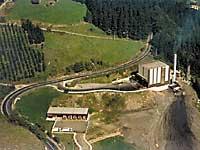
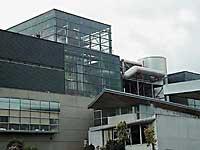
Incinerators of last generation with integrated treatment of dioxins XXI. They are those created in the twentieth century. This is what is going to be done here, but it also does not agree with incinerators, since there are many doubts about the effectiveness of environmental and health safety measures.
Incineration process
The process of burning waste begins with the collection of waste. Industrial waste and urban waste are subjected to mechanical and biological treatment. Burning of inorganic, explosive and radioactive substances is prohibited in incineration furnaces.
Incineration facilities have a reception and a waste deposit to regulate the flow of the amount of waste. Through cranes the waste is placed in the mouth of the incinerator. Both in Zabalgarbi, in Txingudi, and in the incinerator of Aritzeta, the incinerators will have three parts: the grill, the main combustion chamber and the second combustion chamber. The garbage is placed on the grill and along it, upstream, the air and the rest of the fuel that needs combustion is introduced.
In addition to grill incinerators, there are also rotary incinerators with fluid bed system. It seems that rotary incinerators are suitable for burning small amounts of garbage, but not with a lot of garbage. Rotary incinerators have also had problems with emissions into the atmosphere. In fluid bed incinerators, the mixture between the fractions involved in the process is usually better, but combustion requires much more heat. For these reasons it has opted for incinerators with grill.
In grilled incinerators, waste is burned in the main combustion chamber. The tubes that carry water can be installed in the oven to generate water vapor with the heat of combustion and then use this steam to turn a turbine to produce electricity. In some countries of northern Europe it is also used for heating. The combustion gases pass to the second combustion chamber where they are burned again.

Gases must have a minimum temperature of 850 C when leaving the second combustion chamber. If the chlorine ratio of waste is greater than 1%, the temperature should be at least 1,200 C to prevent the formation of dioxins and furans in this process. Gases must remain in the combustion chamber for at least two seconds.
Subsequently, gases and particles pass to the purification system. There, gas is cleaned through water. 1.200 Although the formation of dioxins and furans is avoided, they also appear in the cooling process. Then, if it is burned again, these substances may disappear, but it remains to be demonstrated.
Then the gas, active carbon and filter sleeves, passes through filters, getting trapped particles.
Remains of incineration
In these ashes containing the gas, which have remained in the filters, there are dioxins and furans, both highly toxic, which also accumulate in the organisms. Therefore, ash must be managed as a special waste and once treated it will be sent to landfill.
In Zabalgarbi a pilot research project will be carried out on the possibility of taking advantage of the ashes or not, but there is still no data about it and it is not clear what they will do with the ashes. It seems that the logical thing would be to collect and make a special treatment.

Acids produced between gases and water must be neutralized by lime or soda, a process in which water and salt are generated.
In combustion, between 1,100 and 1,200 C, the remains are melted and a mass material is formed. These residues have high concentrations of heavy metals. When the temperature drops, the mass is solidified by the mineralization process. These sands, after an aging treatment, could be used as materials on road bases or under construction.
The incineration process considerably reduces the volume and weight of the waste, 90% and 75% respectively. This reduces the soil needed for landfills. In addition, you can get hot water and electricity, i.e. recover some of the energy from combustion.
On the other hand, incineration does not destroy pollutants but transforms them. Therefore, if adequate capture and inertization systems are not implemented, the environment, including humans, will suffer serious adverse effects. There is the problem.
Zabalgarbi According to the Vizcaíno Zabalgarbi project, 230,000 tons of waste will be burned per year. The incinerator will power a 90 MW power generator. 33% of the raw materials used for electricity generation will be urban waste and the rest will be fossil fuels. 141 tons of water per hour. 9 tons of slag per hour and 1.1 tons for ash and gas will be generated. It could generate 15% of the electricity consumed in Bizkaia. The installation has involved an investment of 154 million euros and an estimated life of 20 years. |
Xabier Garmendia, editor of technical reports for incinerators
Opinion on the decision
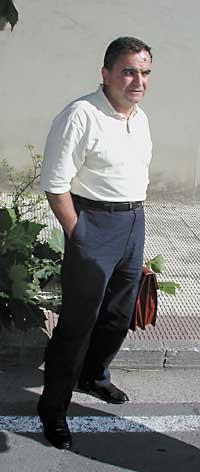
“What we need to take into account in the debate is whether or not this technology has health effects. This technology is controlled, mature, with 200-300 plants in Europe, and health administrations consider it a good way to treat waste. In view of the reality here, and in view of the problems of lack of space, we believe that the best decision for Gipuzkoa and Bizkaia right now is the incinerator”.
About alternatives
“They are mandatory and necessary. When planning, all kinds of solutions must be put on the table. This is a puzzle in which we will have three pieces: prevention, recycling and composting. The remaining and only the remaining will go to the incinerators. How far can we get in percentage? The sum of prevention, recycling and composting can reach 40%, the remaining 60% will go to other treatments, incinerators”.
Waste disposal
“As for the atmosphere and water, with current regulations, emissions are very scarce. Compared to other industrial sectors, much less than traffic.
The debate we have here took place in Europe 15/20 years ago and after various actions and debates it was decided to tighten the regulations. Emissions decreased greatly and at this time emissions from modern incinerators are very low.
The following are solid waste: slag and ash. All metals are removed from the slag. Residues that have not been burned, usually 0.5%, are deposited during a maturation process, leaving them temporarily in the air. Here chemical reactions occur that become inert materials that can be used in civil works.
There are also toxic ashes. If a modern incinerator takes stock of dioxin there are two balances. On the one hand, the amounts of dioxins and furans coming in and out: what comes in is greater than what comes out — between 5 picograms/gram and 60 picograms/gram.
And on the other hand, how much goes into the atmosphere and remains in the escorona and ashes. According to the data we have, 1% leaves the chimney, 18% remains in the slag and 80% in the ashes.
For health, 5% of dioxins enter a person's body when breathing and 95% of food. When people say that living with an incinerator is very dangerous, you have to take into account how much poison comes out and how what comes out enters the body.

Toxic ash by weight does not reach 3% of total waste and 1% in volume. In Txingudi 2,500 tons will be withdrawn annually. These should be managed by the normal route, taking them to an authorized manager to stabilize them for later transfer to special landfills.
Control
All combustion values will be monitored 24 hours a day. This information will be collected in the incinerators themselves and in the administration. In addition, more precise controls and measurements will be carried out six times a year.
Txingudi The construction of an incineration plant at the service of the Commonwealth of Txingudi and the municipality of Hendaia in Txingudi and the construction of an incineration plant at the service of the other towns of Gipuzkoa in Aritzeta de Donostia has been approved. The incinerator of Txingudi will be located on land of Hondarribia, next to the road that leads to the port of Gaintxurizketa, occupying an area of 8.5 ha. The Txingudi incinerator will have an annual incineration capacity of 66,000 tons of garbage in a single incinerator. It will be able to burn 8.3 tons of garbage per hour. It will produce 6 MW of power. |

Gai honi buruzko eduki gehiago
Elhuyarrek garatutako teknologia



